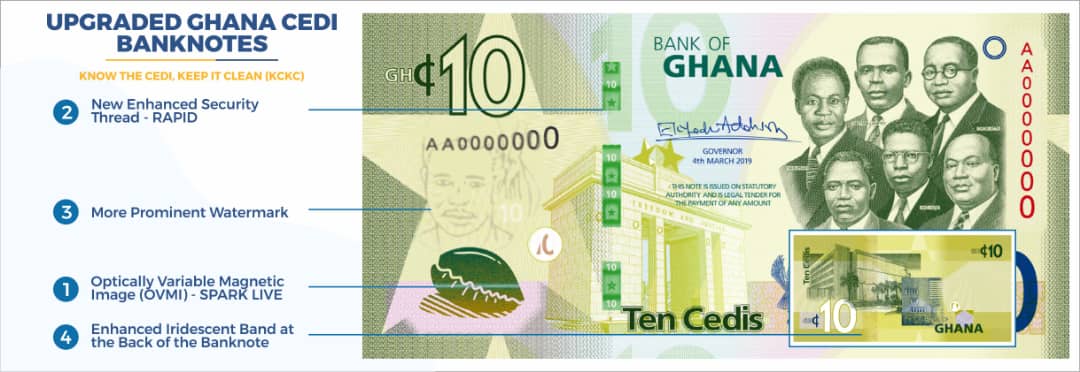

With counterfeiters always strategising to exploit flaws in currencies, Mr Asiedu-Mante, who retired in 2006, said in an interview that regular upgrades in the features help to maintain the integrity of the currency and reduce the tendencies of faking.
Consequently, he commended BoG for the planned introduction of upgraded cedi notes next month that will feature improved and additional security features.
Affected banknotes
The BoG said in a statement issued on April 8 that the upgraded banknotes will co-circulate with existing ones.
The exercise will, however, not affect the GH¢2 and the new GH¢5 banknotes.
While the GH¢2 banknote was introduced in 2010 in response to the need for an intermediary banknote between the GH¢1 and GH¢5 banknotes, the new GH¢5 banknote was introduced in March 2017 to commemorate the 60th anniversary of BoG in that year.
Commenting on the development in an interview on April 9, Mr Asiedu-Mante said BoG’s planned upgrade in the currency, although positive, could also mean that the central bank had noticed a surge in the faking of the cedi.
“Counterfeiters are always ahead and so when there is enough evidence to show that counterfeiting is on the increase, then more security features are introduced,” he said.
He was optimistic that the upgrade in the currency would help reduce counterfeiting, explaining that “once you talk about new security features, it means that you are making it harder for the counterfeiters.”
Frequency of upgrades
He added that the Currency Department of BoG, which issues and receives currencies, normally monitors the level of counterfeiting in the system through fakes notes returned to it from the banks.
“All the banks deposit money with BoG. So, when they bring the money and there are counterfeit notes, they declare them and the Currency Department takes note of them,” he said.
Based on those figures, he said BoG could decide to upgrade the security features in the notes to help reduce the practice and retain public trust in the cedi.
Asked how frequent the upgrade is supposed to be done to help ward off counterfeiters, Mr Asiedu-Mate said there was no timeline, given that faking of the currency is not time bound.
Printers of cedi notes
Mr Asiedu-Mante explained that currency printing was an expensive exercise carried out by specialised firms.
In the case of Ghana, he said the cedi is printed by De La Rue, a security printing firm based in the United Kingdom.
“We have done with firms in Germany and France too; these are security printers and the cost is a huge one.
“They print and charge in British pounds,” he said.
This, he said explained why BoG undertakes occasional public education exercises on how to handle the notes well to reduce the spate of destruction and printing to replace.
“It is because each banknote costs a lot of money. Think of it; the paper, the security features and the ink. A lot goes into it,” he added.
He, therefore, charged the general public to handle the cedi notes well to help prolong their existence.
Printing to finance deficits
Mr Asiedu-Mante explained that apart from upgrade and replacement of worn-out notes that require printing of new notes, a government’s decision to spend more than it raises in revenues often also lead to printing of new money.
Known as deficit financing, the retired central bank deputy boss said whenever the government records a fiscal deficit, “it goes to the central bank to borrow for the government and that means putting extra money into circulation.”
“So, on those occasions, you get the central bank putting in money that is not necessarily due to the replacement of a deformed one or introduction of new features,” he said.
Co-circulation
He explained that the decision to allow the upgraded banknotes to co-circulate with existing ones was to ensure that the exercise does not cause “panic and havoc.”
“As soon as the old one gets to BoG, it will be withdrawn from circulation and the equivalent in the new one is brought out,” he said, adding that this should make it a seamless operation.